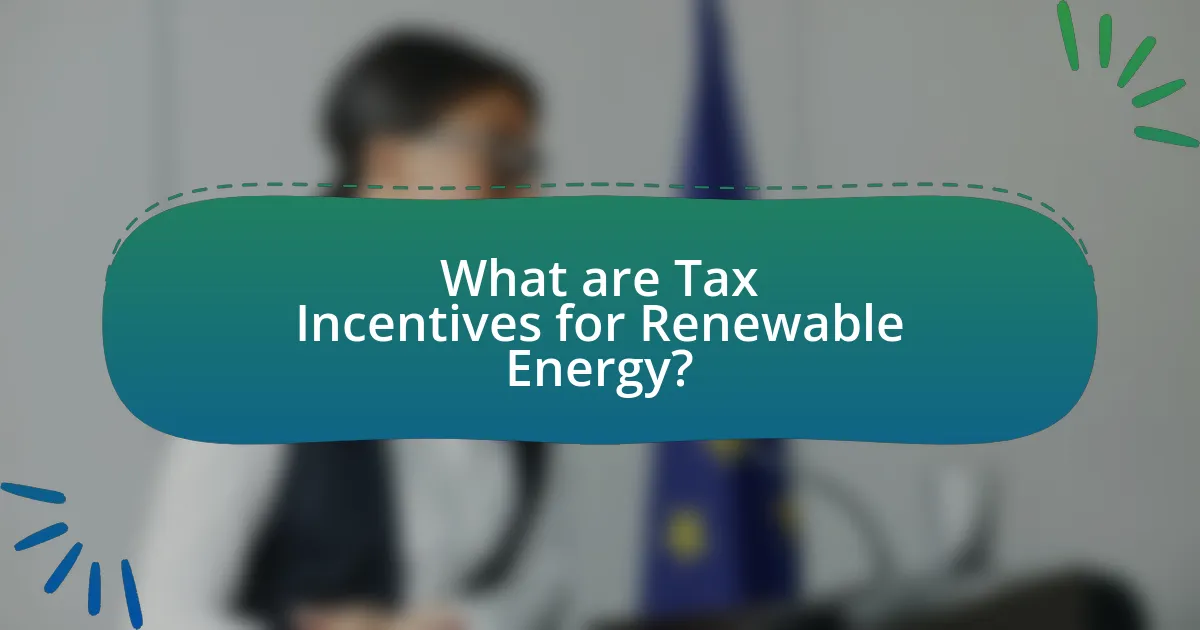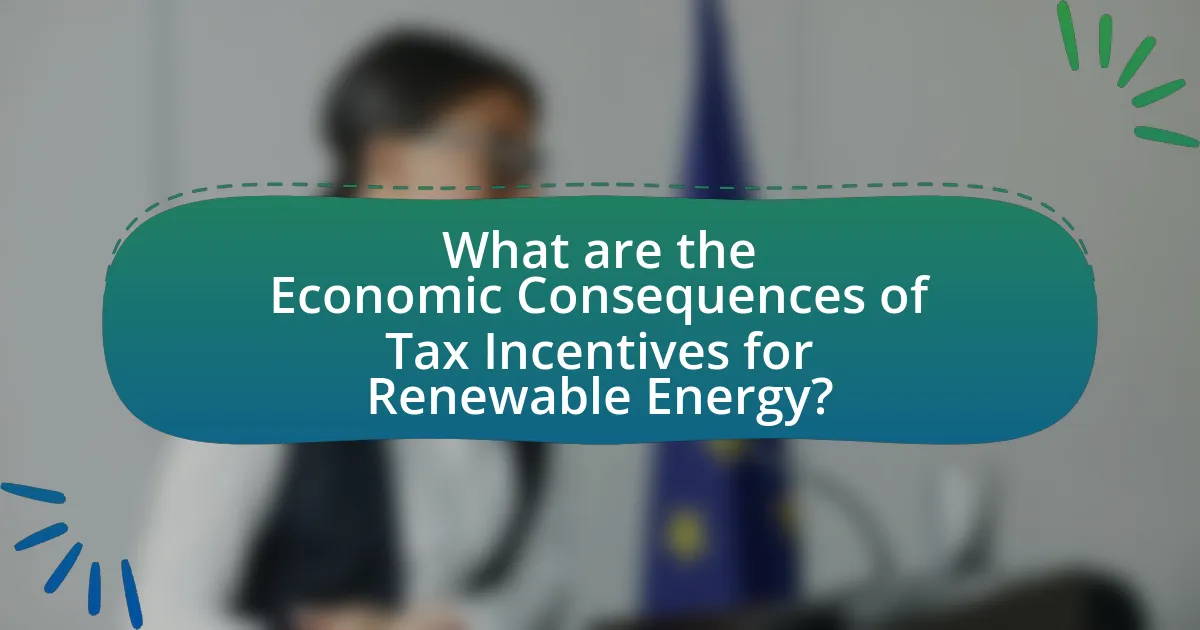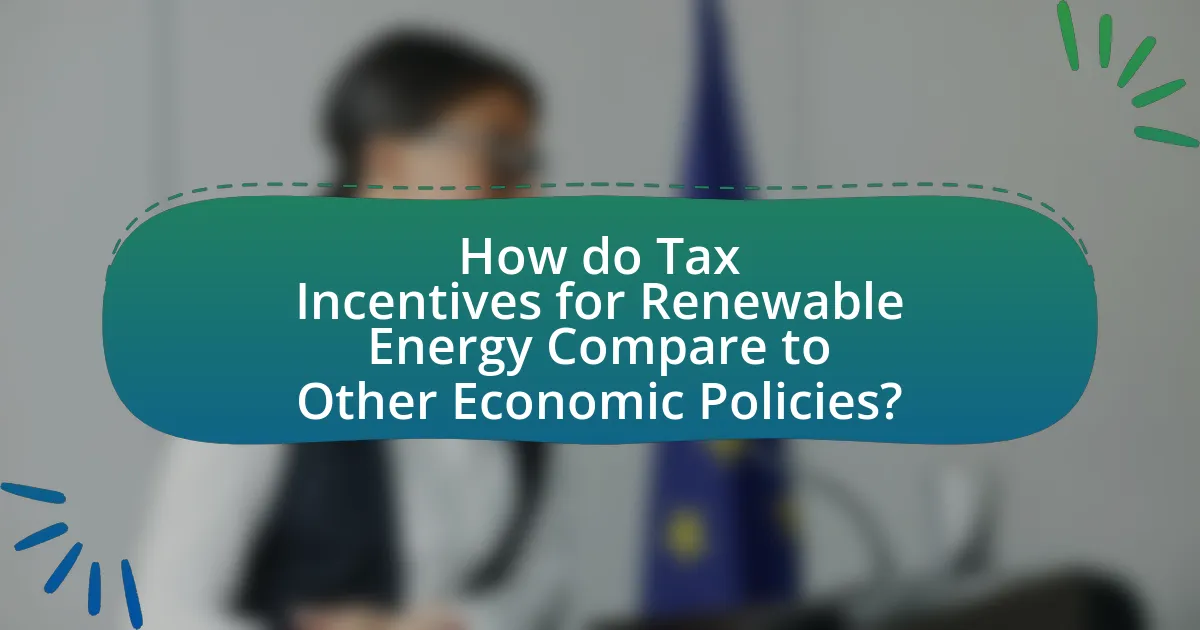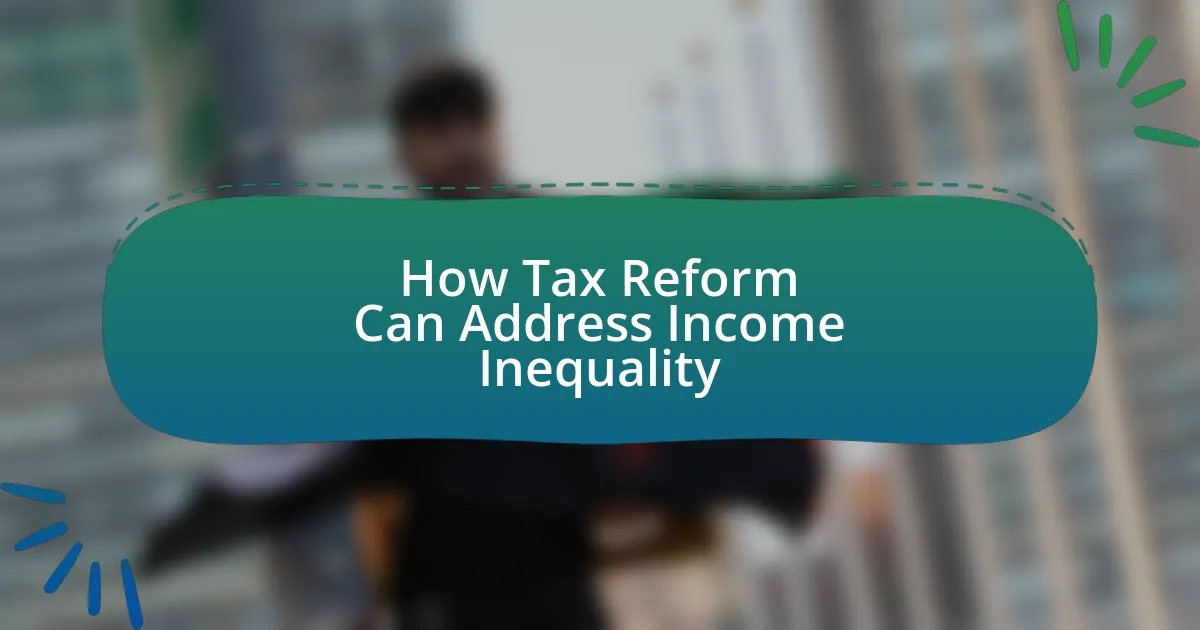Tax incentives for renewable energy are financial benefits provided by governments to promote the development and use of renewable energy sources, including tax credits, deductions, grants, and rebates. These incentives significantly lower the costs associated with renewable energy projects, driving investment and job creation in the sector. The article analyzes the economic consequences of these incentives, highlighting their role in increasing renewable energy capacity, fostering innovation, and enhancing energy security. It also discusses the variations in tax incentives across regions, their impact on job creation and wage levels, potential economic drawbacks, and best practices for implementation to ensure effectiveness and equity.

What are Tax Incentives for Renewable Energy?
Tax incentives for renewable energy are financial benefits provided by governments to encourage the development and use of renewable energy sources. These incentives can take various forms, including tax credits, tax deductions, grants, and rebates, aimed at reducing the overall cost of renewable energy projects. For instance, the Investment Tax Credit (ITC) in the United States allows developers to deduct a significant percentage of the cost of solar energy systems from their federal taxes, which has been instrumental in increasing solar installations. According to the Solar Energy Industries Association, the ITC has contributed to a more than 10-fold increase in solar capacity since its inception in 2006, demonstrating the effectiveness of tax incentives in promoting renewable energy adoption.
How do tax incentives function in the renewable energy sector?
Tax incentives in the renewable energy sector function by providing financial benefits to individuals and businesses that invest in renewable energy technologies. These incentives, such as tax credits, deductions, and grants, lower the overall cost of renewable energy projects, making them more attractive to investors. For example, the Investment Tax Credit (ITC) allows investors to deduct a significant percentage of the cost of solar energy systems from their federal taxes, which has been instrumental in driving solar installations in the United States. According to the Solar Energy Industries Association, the ITC has contributed to a more than 10-fold increase in solar capacity since its inception in 2006, demonstrating the effectiveness of tax incentives in promoting renewable energy adoption.
What types of tax incentives are available for renewable energy projects?
Tax incentives for renewable energy projects include the Investment Tax Credit (ITC), the Production Tax Credit (PTC), and various state-level incentives. The ITC allows investors to deduct a percentage of the investment cost from federal taxes, which was 26% for projects started in 2020 and 2021, decreasing to 22% for projects started in 2022. The PTC provides a per-kilowatt-hour tax credit for electricity generated by qualified renewable energy sources, such as wind and solar, for the first ten years of operation. Additionally, many states offer their own tax credits, grants, or property tax exemptions to further encourage renewable energy development, enhancing the financial viability of these projects.
How do these incentives vary by region or country?
Tax incentives for renewable energy vary significantly by region and country, influenced by local policies, economic conditions, and environmental goals. For instance, the United States offers a federal Investment Tax Credit (ITC) and Production Tax Credit (PTC), while European countries like Germany and Spain provide feed-in tariffs and direct subsidies to promote renewable energy adoption. In contrast, developing nations may rely on international funding and partnerships to implement similar incentives, often resulting in less comprehensive support. According to the International Renewable Energy Agency (IRENA), as of 2021, countries like China and India have also established substantial incentives, including tax exemptions and grants, to accelerate renewable energy projects, reflecting their commitment to sustainable development.
Why are tax incentives important for renewable energy development?
Tax incentives are crucial for renewable energy development because they lower the financial barriers for investment in clean energy technologies. By providing tax credits, deductions, or exemptions, governments encourage businesses and individuals to invest in renewable energy projects, which can lead to increased deployment of solar, wind, and other sustainable energy sources. For instance, the Investment Tax Credit (ITC) in the United States has been instrumental in driving solar energy growth, contributing to a 167% increase in solar capacity from 2016 to 2020. This demonstrates that tax incentives effectively stimulate market activity and foster innovation in the renewable energy sector.
What role do tax incentives play in attracting investment?
Tax incentives significantly enhance the attractiveness of investment by reducing the overall cost of capital for investors. These incentives, such as tax credits, deductions, and exemptions, lower the financial burden on businesses, making projects more viable and appealing. For instance, the Investment Tax Credit (ITC) in the United States has been instrumental in driving investments in renewable energy, contributing to a 70% increase in solar capacity from 2010 to 2020. This demonstrates that tax incentives effectively stimulate investment by improving return on investment and encouraging capital allocation towards sectors like renewable energy.
How do tax incentives impact the cost of renewable energy technologies?
Tax incentives significantly reduce the cost of renewable energy technologies by lowering the financial burden on developers and consumers. These incentives, such as tax credits and deductions, encourage investment in renewable energy projects, making them more economically viable. For instance, the Investment Tax Credit (ITC) in the United States allows developers to deduct a substantial percentage of the cost of solar energy systems from their federal taxes, which has led to a dramatic increase in solar installations. According to the Solar Energy Industries Association, the ITC has contributed to a 167% increase in solar capacity from 2016 to 2020. This demonstrates that tax incentives effectively lower upfront costs, stimulate market growth, and enhance the competitiveness of renewable energy technologies.

What are the Economic Consequences of Tax Incentives for Renewable Energy?
Tax incentives for renewable energy lead to increased investment in the sector, resulting in job creation and economic growth. For instance, the U.S. solar industry employed over 250,000 workers in 2019, largely due to federal tax credits like the Investment Tax Credit (ITC) and the Production Tax Credit (PTC). These incentives stimulate demand for renewable technologies, driving innovation and reducing costs. A study by the International Renewable Energy Agency (IRENA) found that every $1 million invested in renewable energy creates approximately 7.5 jobs, compared to 2.65 jobs in fossil fuel sectors. Additionally, tax incentives can enhance energy security and reduce reliance on imported fuels, contributing to a more stable economy.
How do tax incentives influence job creation in the renewable energy sector?
Tax incentives significantly enhance job creation in the renewable energy sector by lowering operational costs and encouraging investment. These financial benefits, such as tax credits and deductions, stimulate companies to expand their workforce to meet increased demand for renewable energy projects. For instance, the Solar Investment Tax Credit (ITC) has been linked to the creation of over 250,000 jobs in the solar industry since its implementation, demonstrating a direct correlation between tax incentives and employment growth. Additionally, studies indicate that every megawatt of solar capacity installed creates approximately 5.65 jobs, further illustrating how tax incentives drive job creation in this sector.
What types of jobs are most affected by these incentives?
Jobs in the renewable energy sector, particularly in solar and wind energy, are most affected by tax incentives. These incentives stimulate job creation in areas such as manufacturing, installation, and maintenance of renewable energy technologies. For instance, the Solar Foundation’s National Solar Jobs Census reported that the U.S. solar industry employed over 250,000 workers in 2019, largely due to supportive policies and tax incentives. Similarly, the American Wind Energy Association noted that wind energy jobs have increased significantly, with over 100,000 workers employed in the sector as of 2020, driven by federal tax credits.
How do tax incentives affect wage levels in the renewable energy industry?
Tax incentives generally lead to increased wage levels in the renewable energy industry by stimulating investment and job creation. When governments offer tax breaks or credits, companies are more likely to invest in renewable energy projects, which can result in higher demand for skilled labor. For instance, a study by the National Renewable Energy Laboratory found that states with robust renewable energy tax incentives experienced wage growth in the sector, with average wages for solar and wind jobs exceeding the national average for similar positions. This correlation indicates that tax incentives not only encourage industry growth but also enhance wage competitiveness, benefiting workers in the renewable energy field.
What are the potential economic drawbacks of tax incentives for renewable energy?
Tax incentives for renewable energy can lead to significant economic drawbacks, including market distortion and dependency on government support. These incentives may encourage inefficient allocation of resources, as companies might prioritize projects that qualify for tax breaks over potentially more beneficial investments. For instance, a study by the International Renewable Energy Agency found that excessive reliance on subsidies can stifle innovation by reducing competitive pressure, ultimately leading to higher costs for consumers. Additionally, tax incentives can create budgetary pressures on governments, diverting funds from other critical areas such as education and infrastructure.
How can tax incentives lead to market distortions?
Tax incentives can lead to market distortions by artificially altering the supply and demand dynamics within an industry. When governments provide tax breaks or credits for renewable energy, they can create an imbalance by encouraging overinvestment in certain technologies or sectors, regardless of their actual market viability. For instance, the U.S. solar investment tax credit has spurred rapid growth in solar installations, but it has also led to market saturation in some areas, resulting in price drops that can harm less efficient producers. This misallocation of resources can stifle competition and innovation, as firms may rely on incentives rather than improving efficiency or reducing costs.
What are the long-term fiscal implications of these incentives for governments?
The long-term fiscal implications of tax incentives for renewable energy on governments include potential revenue losses and shifts in budget allocations. These incentives often reduce tax revenues in the short term, as governments forgo income to stimulate investment in renewable technologies. For instance, the U.S. federal government provided approximately $29 billion in tax incentives for renewable energy in 2020, which can lead to significant budgetary constraints over time. However, these incentives can also result in long-term economic benefits, such as job creation and reduced healthcare costs from improved air quality, which may offset initial revenue losses. Studies indicate that every dollar invested in renewable energy can yield up to $3 in economic returns, suggesting that while immediate fiscal impacts may be negative, the long-term benefits could enhance government revenues through increased economic activity and tax bases.

How do Tax Incentives for Renewable Energy Compare to Other Economic Policies?
Tax incentives for renewable energy are generally more effective in promoting sustainable economic growth compared to traditional economic policies. These incentives, such as tax credits and deductions, directly lower the cost of renewable energy projects, leading to increased investment and job creation in the green sector. For instance, the Investment Tax Credit (ITC) has been credited with driving a significant increase in solar energy installations, contributing to a 167% growth in solar capacity from 2016 to 2020, according to the Solar Energy Industries Association. In contrast, other economic policies, like general tax cuts or subsidies for fossil fuels, often do not yield the same level of targeted investment in sustainable technologies and can perpetuate reliance on non-renewable energy sources. Thus, tax incentives for renewable energy not only stimulate immediate economic activity but also align with long-term environmental goals, making them a more strategic choice in economic policy.
What are the advantages of tax incentives over direct subsidies?
Tax incentives offer several advantages over direct subsidies, primarily in terms of cost-effectiveness and flexibility. Tax incentives reduce the financial burden on governments by allowing them to forgo tax revenue rather than directly spending funds, which can lead to a more sustainable fiscal approach. For instance, a study by the International Renewable Energy Agency (IRENA) found that tax incentives can stimulate investment in renewable energy projects without the immediate cash outflow associated with subsidies. Additionally, tax incentives can be tailored to specific industries or projects, providing targeted support that can adapt to changing market conditions, unlike direct subsidies that may be more rigid and less responsive to economic shifts.
How do tax incentives affect market competition compared to other policies?
Tax incentives enhance market competition by lowering operational costs for businesses, thereby encouraging investment and innovation. Unlike regulatory policies, which may impose restrictions or compliance costs, tax incentives directly reduce financial burdens, allowing companies to allocate resources toward growth and competitive strategies. For instance, the Investment Tax Credit (ITC) for renewable energy projects has led to a significant increase in solar installations, with a reported 167% growth in capacity from 2010 to 2020, demonstrating how tax incentives can stimulate market activity more effectively than traditional regulatory measures.
What are the administrative challenges associated with tax incentives?
Administrative challenges associated with tax incentives include complexity in compliance, difficulties in monitoring and enforcement, and the potential for fraud. The complexity arises from the intricate rules and regulations that businesses must navigate to qualify for incentives, which can lead to errors and increased administrative costs. Monitoring and enforcement challenges stem from the need for government agencies to track the effectiveness and proper use of these incentives, often requiring significant resources and expertise. Additionally, the potential for fraud exists as some entities may misrepresent their eligibility or the extent of their renewable energy investments, undermining the intended benefits of the incentives. These challenges can hinder the effectiveness of tax incentives in promoting renewable energy initiatives.
How do tax incentives for renewable energy align with broader economic goals?
Tax incentives for renewable energy support broader economic goals by promoting sustainable development and job creation. These incentives, such as tax credits and deductions, encourage investment in clean energy technologies, which can lead to a reduction in greenhouse gas emissions and a transition to a low-carbon economy. For instance, the U.S. solar industry employed over 250,000 workers in 2020, demonstrating how tax incentives can stimulate job growth while addressing climate change. Additionally, the International Renewable Energy Agency reported that renewable energy could contribute up to $2 trillion to the global economy by 2030, highlighting the economic benefits of transitioning to renewable sources.
What impact do these incentives have on energy independence and security?
Tax incentives for renewable energy significantly enhance energy independence and security by promoting domestic energy production and reducing reliance on foreign fossil fuels. These incentives, such as tax credits and grants, encourage investments in renewable technologies like solar and wind, which in turn lead to increased energy generation from local sources. For example, the U.S. Energy Information Administration reported that renewable energy sources accounted for 20% of total electricity generation in 2020, a figure bolstered by federal tax incentives. This shift not only diversifies the energy supply but also mitigates the risks associated with geopolitical tensions and fluctuating fossil fuel prices, thereby strengthening national energy security.
How do tax incentives contribute to sustainable economic growth?
Tax incentives contribute to sustainable economic growth by encouraging investments in renewable energy and green technologies. These incentives, such as tax credits and deductions, lower the financial barriers for businesses and individuals to adopt sustainable practices. For instance, the Investment Tax Credit (ITC) in the United States has led to a significant increase in solar energy installations, with a reported growth of over 1,600% in solar capacity from 2010 to 2020. This surge not only creates jobs in the renewable sector but also stimulates local economies through increased demand for related services and products. Furthermore, by promoting cleaner energy sources, tax incentives help reduce greenhouse gas emissions, aligning economic growth with environmental sustainability.
What best practices should be considered when implementing tax incentives for renewable energy?
When implementing tax incentives for renewable energy, best practices include ensuring clarity and simplicity in the incentive structure, targeting specific technologies or sectors, and regularly evaluating the effectiveness of the incentives. Clear and simple tax incentives facilitate understanding and compliance among stakeholders, which is crucial for maximizing participation and investment. Targeting specific technologies, such as solar or wind, allows for focused support where it is most needed, enhancing the overall impact on renewable energy adoption. Regular evaluations, supported by data from sources like the International Renewable Energy Agency, help in adjusting policies based on performance metrics, ensuring that the incentives remain effective and aligned with evolving market conditions.
How can policymakers ensure that tax incentives are effective and equitable?
Policymakers can ensure that tax incentives are effective and equitable by implementing targeted assessments and regular evaluations of the incentives’ impact on various demographics and sectors. This approach allows for the identification of disparities in benefits and ensures that incentives are aligned with broader economic goals, such as promoting renewable energy adoption. For instance, studies have shown that tax incentives for renewable energy can lead to significant job creation and investment in underserved communities when designed with equity in mind. By utilizing data analytics and stakeholder feedback, policymakers can adjust incentives to maximize both effectiveness and fairness, thereby fostering a more inclusive economic environment.
What metrics should be used to evaluate the success of tax incentives?
The metrics used to evaluate the success of tax incentives include economic growth, job creation, investment levels, and environmental impact. Economic growth can be measured by changes in GDP attributable to the incentives, while job creation is assessed through the number of new jobs generated in the renewable energy sector. Investment levels are quantified by the amount of capital invested in renewable energy projects as a direct result of the incentives. Environmental impact is evaluated through reductions in greenhouse gas emissions and increases in renewable energy production. These metrics provide a comprehensive framework for assessing the effectiveness of tax incentives in promoting renewable energy initiatives.




